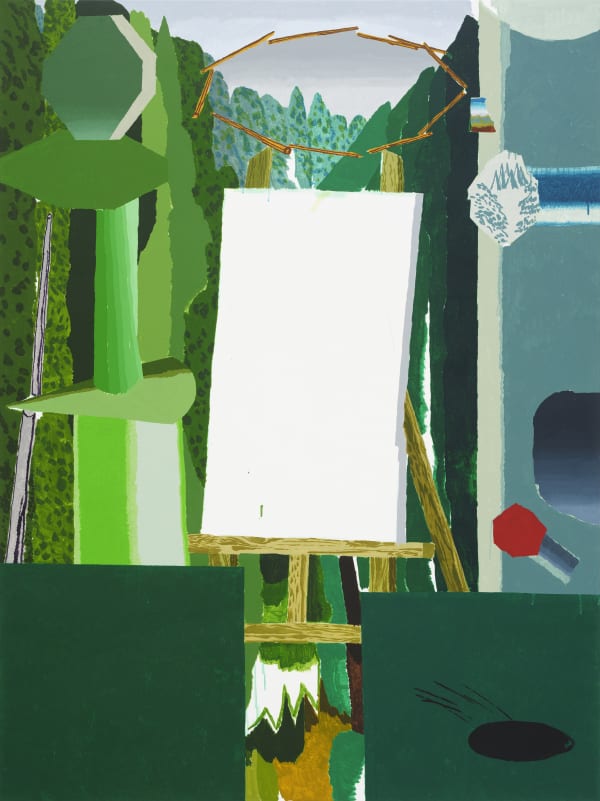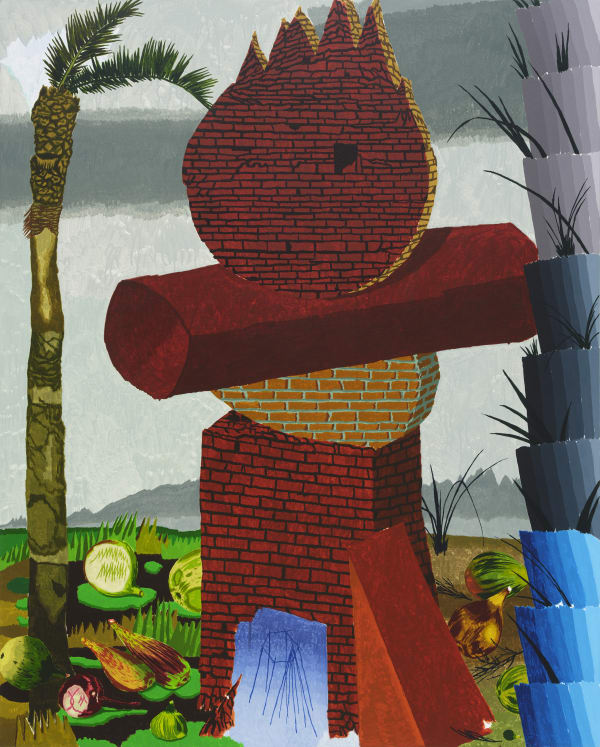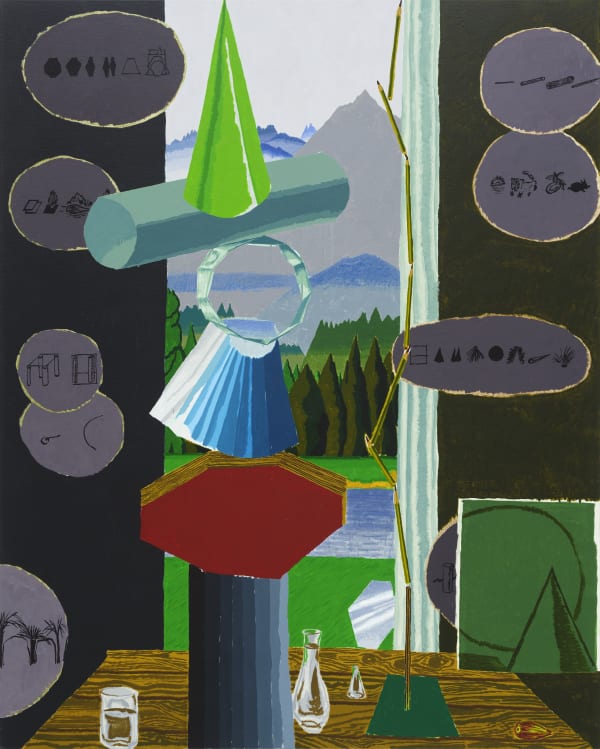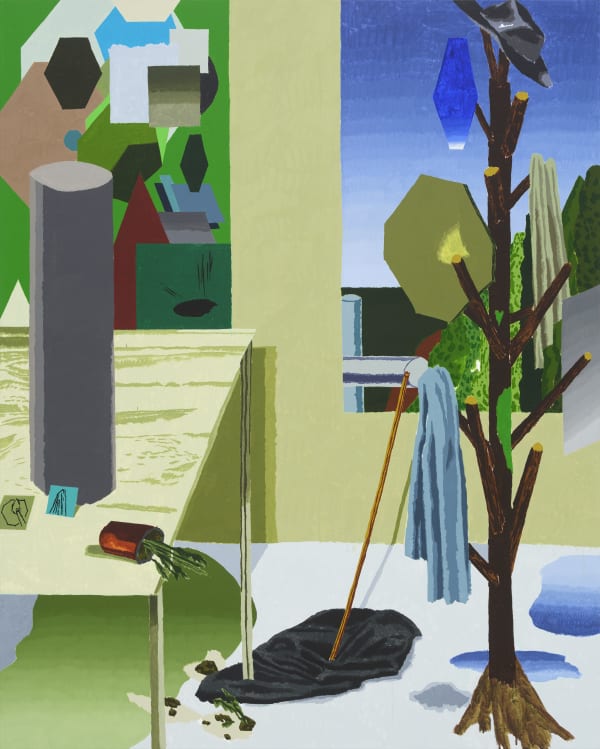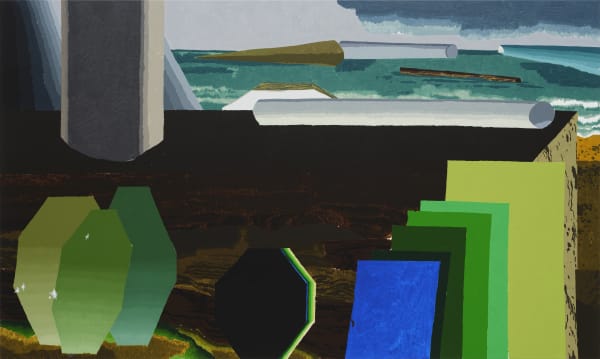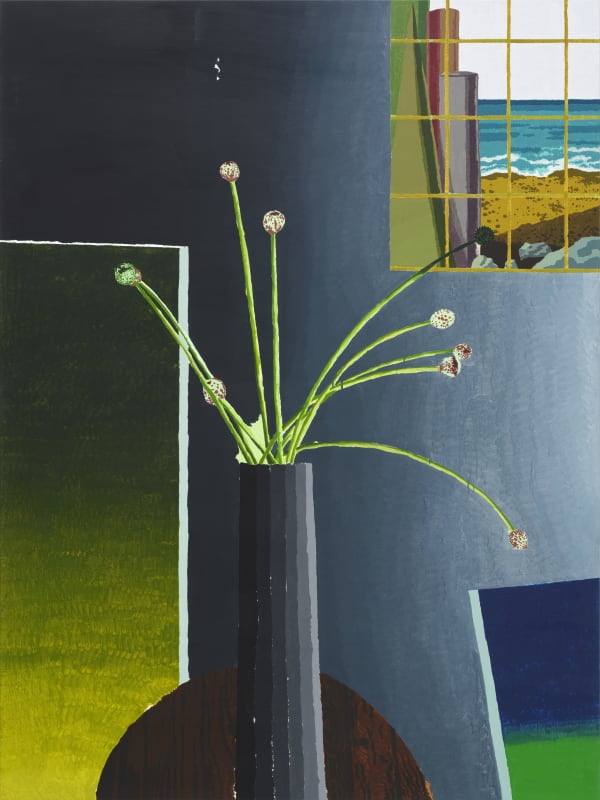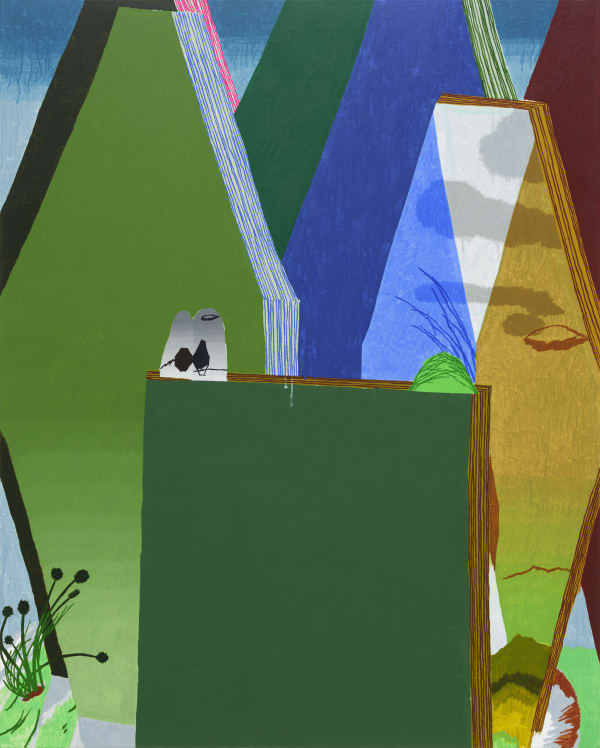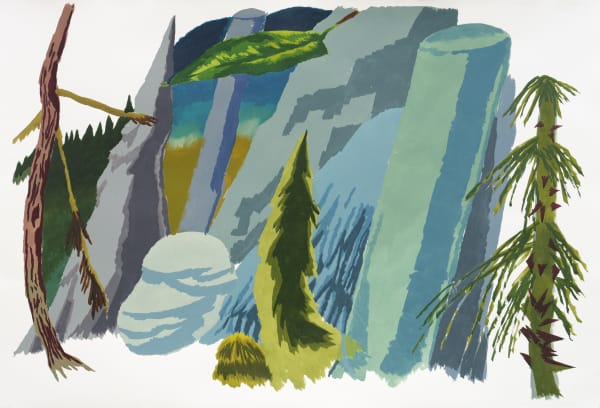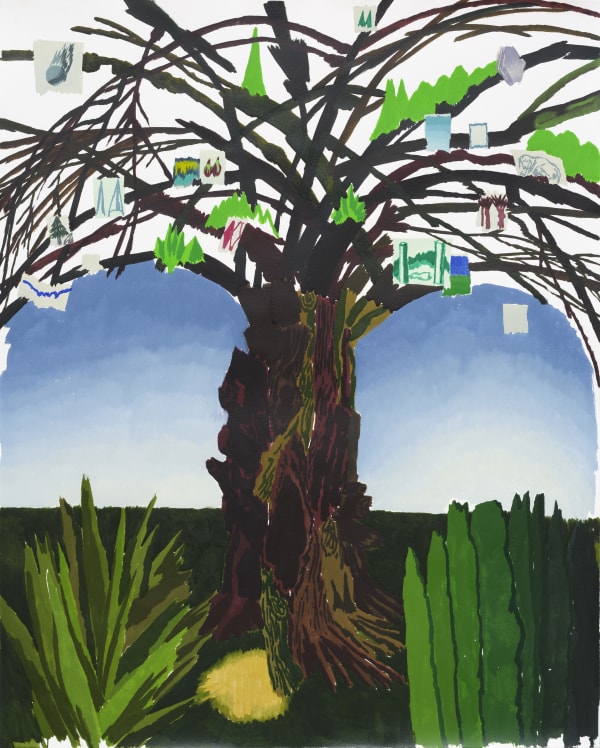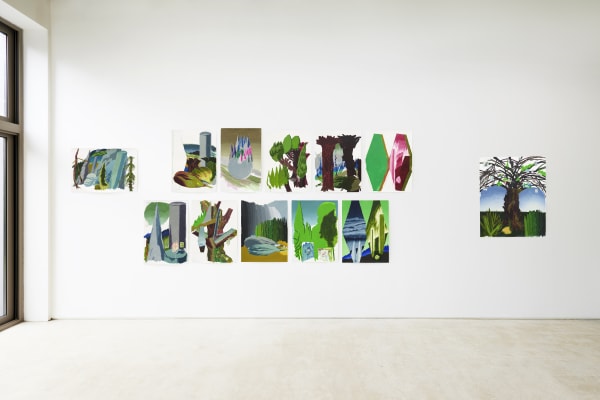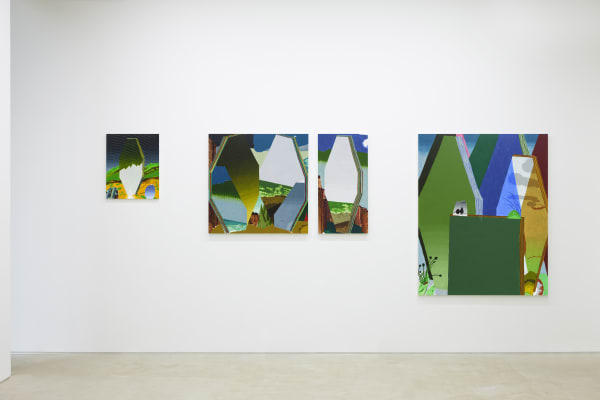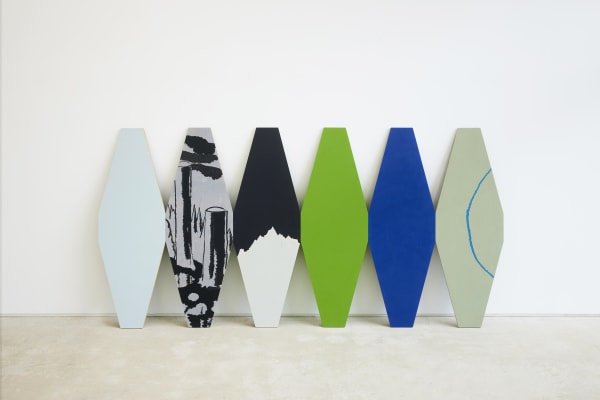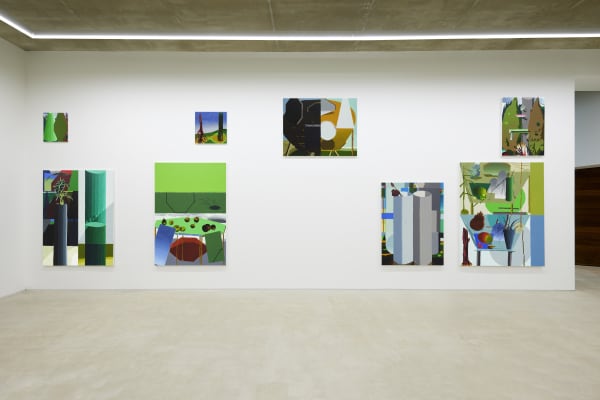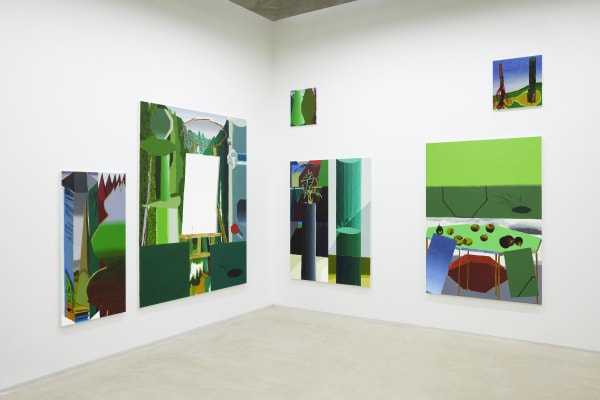Meet Me in the Middle: 전현선 Hyunsun Jeon
타자를 온전히 이해할 수 있을까. 전현선은 스스로에게 질문한다. 만약 그것이 불가능하다면 어느 정도는 포기하고 적당한 거리를 유지해야 할 것이다. 즉, 서로 조금씩 타협한 중간 지점에서 타자와 만나야 한다. 이번 개인전 《Meet Me in the Middle》은 서로 다른 두 대상 사이의 ‘중간’을 탐구한다. 물리적으로 이것은 어느 쪽도 무리하지 않고 만나는 장소를 의미한다. 하지만 작가는 단지 둘 사이의 평등한 지점으로만 ‘중간’을 사유하지 않는다. 두 대상이 서로를 이해하기 위해 상대의 시각과 입장을 가져보는 일, 상대방의 상황과 신체 조건을 상상해 보는 것. 그리고 이 모든 것은 결국 불가능하다는 사실을 깨달았을 때 한 발짝 물러난 지점.
그림은 타자를 이해하기 위한 시도와 거기서 일어나는 상황을 묘사한다. 더 나아가 그는 그림의 ‘중간’을 꾀한다. 여러 번 겹쳐서 색을 칠하고 형태를 견고하게 다듬었던 이전과 달리 이번에는 즉흥적으로 형태를 결정하고 과감한 큰 붓질로 채색했다. 이는 이번 작업이 드로잉에서 출발했기 때문이다. 캔버스를 지지체로 하는 회화가 화가의 최종 목적지라면 드로잉은 중간 그 어디쯤일 것이다. 그곳은 균일한 붓질, 안정적인 구도, 정갈하고 정적인 분위기가 아닌 거친 붓질, 여백, 즉흥적인 형태, 동적인 분위기의 자리이다. 그리고 그 자리가 바로 작가도 중간까지 가고 형태도 중간까지 와준 자리이다.
그림에 등장하는 도형들은 작가가 경험하고 이해한 인간관계, 사물, 상황을 상징하는 추상적인 형태이자 작업의 원동력이다. 자신에게 도형은 무색무취의 배우와 같다고 말한다. 다양한 성대모사와 분장이 가능한 큰 특징이 없고 까다롭지 않은 배우 말이다. 그는 2020년 개인전부터 의인화된 도형들이 한 화면에 나란히 서 있는 모습을 보여줬다. 이제 그들은 다름을 넘어서 서로를 이해하려고 노력하기도 하고 온전한 이해가 불가능함을 체현하기도 하고 둘 사이의 적절한 타협점을 찾아가기도 한다. 도형들의 뛰어난 연기력과 여러 상황은 자연스럽게 그림의 서사를 만들어 냈다.
그림은 4개의 챕터로 나눠진다. 첫 번째 챕터인 ‘두 개의 사물’에서는 다양한 관계를 상징하는 두 개의 개체가 등장하는데 서로에게 융화되려고 노력하는 그들의 모습이나 상황을 보여준다. 두 번째 ‘창문’은 나와 타자와의 좁혀질 수 없는 거리감을 묘사한다. 전현선은 ‘타자란 창문을 통해 본 풍경’ 같다고 말한다. 아주 가까이 있는 것 같지만 나와 상대방이 서 있는 곳은 결국 다른 장소이며 프레임을 통해서 상대방의 일부만 볼 수 있다. 세 번째 ‘거울’은 팔각형의 도형들이 거울이 되어 타자를 그대로 반영하려는 모습을 보여준다. 하지만 상대방을 있는 그대로 반영하려고 해도 ‘나’의 위치와 각도에 따라 반영되는 상이 다를 수밖에 없다. 마지막으로 ‘조각상’에 서는 기념비 같은 조각상들이 등장한다. 이것은 둘 사이에 세워진 임시적인 해결책을 의미한다. 그 해결책(조각상)은 안정적이지도 견고하지도 않다. 언제든지 무너질 수 있는 불완전한 합의점이다.
<두 개의 실내>(챕터 ‘창문’)에서 두 대상은 바닥의 검은 옷을 밟는 상황을 통해 조우한다. 그리고 뒤에는 창문이 있다. 이것은 서로가 생각하는 상대방의 이미지다. <아직 거기에 계속 서 있다면>(챕터 ‘거울’)에서 팔각형의 거울들은 모두 한 방향을 바라보고 있다. 작가는 과거에 미처 알아차리지 못했던 타자의 제스처나 말이 문득문득 떠오를 때가 있다고 한다. 자신의 착오와 둔함을 깨달은 현재의 내가 그때로 다시 돌아간다면 어떻게 했을까라고 생각해보지만, 시간을 되돌릴 순 없다. 도형들은 건널 수 없는 강을 바라본다. 그런데 도형들이 비추고 있는 것은 강이 아니라 각자의 과거다. <중간에서 그리는 그림>은 두 대상 사이의 중간에서 그린 그림이다. 중간의 합의점을 그려야 하는 상황이다. 그런데 서로가 만족할 만한 그림이 존재할 수 있을까. 캔버스는 아직 비워진 상태이다.
이번 작업은 전현선의 반려견인 ‘아놀드’의 시간을 생각하면서 시작됐다고 한다. 인간이 실제로 개가 되거나 서로 말이 통하지 않으니 인간은 그들의 마음을 정확하게 알 수 없다. 중요한 것은 서로 온전히 이해하지 못하더라도 한 공간에서 시간을 공유하는 것이다. 그리고 공유한 그 시간과 공간이 그들의 중간 지점일 것이다. 애석하게도 우리는 나 자신이 아닌 그 어떤 것도 온전히 이해할 수 없다. 하지만 다름을 인정하고 이해하기 위해 노력해 보는 것, 그 과정 자체에 의미가 있다. 작가는 이 점이 그림과 연결된다고 말한다. 그림은 정답을 찾거나 결론에 도달하는 것이 아닌 질문을 던져보는 것만으로 의미가 있다. 그는 그런 믿음을 갖고 있다.
두 대상 사이의 중간은 어디인가. 그곳이 인간관계의 최종 목표 지점인가. 둘이 동일한 시간과 에너지를 써서 만나는 지점만이 중간은 아닐 것이다. 한쪽이 아홉 걸음을 다가가도 혹은 그저 한 걸음만 다가가도 결국 모두 ‘중간’일 뿐이다. 또한 한쪽이 일방적으로 희생하는 관계 역시 오래 지속될 수 없다. 상대방을 더 알고 싶지만, 온전히 그럴 수 없어 머무르거나 물러난 지점. 그 중간에 머무는 것 자체가 서글프지만 아름다운 일이다. 전현선은 둘 사이의 명확한 중간은 없고 또 그 중간은 언제라도 움직일 수 있다고 그림으로 말한다. 이 또한 서글프고 아름다운 일이다.
Painter Jeon Hyunsun casts a question of whether or not the other can be wholly understood. The question is cast at herself, where she stands. If the other cannot be wholly understood, then it may be advisable to accept certain realities and keep a sensible distance to the other. A distance that is not severance or summary dismissal, but a meet-halfway arrangement where there is compromise between the self and the other. Jeon's latest solo exhibition 《Meet Me in the Middle》 explores that middle-ground compromise where two heterogenic objects meet. The meeting occurs in a physical space where neither party is burdened excessively. However, Jeon envisioned more than just an equilateral relative distance between two parties. She imagined a point of compromise, of standing in the shoes of the other, of having perspective, even imagining the other's situation and physical condition. She imagined that with as much specificity as she could muster, and in the process recognized such an absolute transposition was impossible. The middle in the realistic, functional sense was a step back from the ideal.
Her painted images are an understanding of the external other, and what occurs beyond the self. The artist pursues a median-ness of paintings. Her previous works were of multiple layers of painted colors with solid forms and robustly iterated lines, but her brushwork was motivated by improvised forms and bold swaths of color this solo exhibition. It was the dessin sketches that allowed her this freedom. If the blank canvas was the foundation and the substrate of paint the roof, dessin sketches were the scaffolding. The ambiguous and equivocal in-between state is a place of coarser brushstrokes, negative spaces, improvisational forms, and dynamic ambiance. Working with scaffolding freed her brush of rigid uniformity, solid compositions, or a stable - static - atmosphere. It just so happens that the in-between place is where the artist and her drawn forms met in the middle through mutual compromise.
Geometric forms in her paintings are abstractions of her experienced and understood interpersonal relationships, objects, and situations. They inform her work. To her, the geometric forms are like versatile character actors who disappear behind the characters they embody, under even the lightest makeup and twist of inflection. They are not too distinct and not too demanding. These anthropomorphized geometric forms first appeared in Jeon's 2020 solo exhibition, and now they seek an understanding of the other beyond differences, embodying and embracing the impossibility of wholly understanding. They find suitable compromises between the two. Like actors, the geometric forms and their presented situations tell a rich narrative for her paintings.
The drawing is divided into four chapters. The first chapter Two Objects is of two objects representing multifarious relationships. It is a presentation of how they seek to integrate and reach equilibrium with one another. The second chapter Window describes the minimal non-reducible distance between the self and the other. Jeon states, "the other is like a scene viewed through a window." The other might seem close, but they occupy a separate space and place. What you perceive through the window is in fact framed in such a way that the whole is not available. The third chapter Mirror shows octagonal forms as mirrors trying to reflect the other as-is. The problem is that reflections are not full and square reflections of the whole being. They can show only a part, in varying ways depending on angle and position. The fourth and final chapter Sculpture presents monument-like statues that signify temporary solutions between two parties. As they are temporary, they lack stability and robustness. The solution, the consensus, is incomplete at best, collapsible at any moment.
⟨Double Spaces⟩ of the Window chapter presents two foreground subjects who encounter each other through a circumstance of stepping on a black clothing item on the floor. Two windows are open in the background, frames of how the subjects perceive the other. ⟨If You're Still Standing There⟩ of the Mirror chapter positions elongated octagonal mirrors in one direction only. The artist is randomly reminded of past gestures and statements by others that she overlooked in the past. Only now realizing her oversight, misunderstanding, or ignorance, she wonders what might have been done had she understood the situation more wholly. Yet that is how time is. She is in the now and that was in the past. The geometric forms face a river that cannot be forded. It is not the river that the mirrors show, but the past of the other. ⟨Paint in the Middle⟩ was painted between two objects. The situation demands an intermediate agreement, but does the middle-ground painting ever satisfy anyone? The canvas remains unpopulated.
Jeon Hyunsun explains that her recent works started as thoughts of time shared with Arnold, her pet dog. People and dogs do not share a language, so understanding dogs is not always easy. Instead of speech, the best we can do instead is to share plenty of time together in close quarters. Between people and dogs, that middle-ground is time and space shared. Understanding anything beyond the self is nearly impossible, yet the effort and journey of trying to understand, of accepting the differences is what matters. The artist describes this point as what connects with the painting. Paintings don't need to present answers or reach conclusions. Merely casting them out there can be meaningful. Jeon has faith in that.
Where lies that middle ground? Is that the final destination of all interpersonal relationships? Just because the two parties expended comparable time and energy to meet at a certain point doesn't qualify it as middle. One might take nine steps while the other only takes one, but is that not wholly compromise found in the middle? That is not to say that the compromise remains in static position, or in a way that one takes more steps to the other. Such relationships pass quickly. A point between two others who sought mutual and whole understanding but had to compromise somewhere in-between. That in-between may be reason for dolor, but that pause is also a point of beauty. Jeon Hyunsun's paintings speak of a floating-point middle-ground that is neither static nor clearly defined. The middle can always move. That too, is a sad and wondrous thing.
